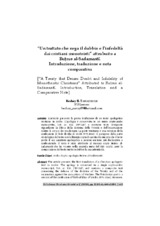“Un trattato che nega il dubbio e lʼinfedeltà dai cristiani monoteisti” attrubuito a Buṭrus al-Sadamantī. Introduzione, traduzione e nota comparativa
“A Treaty that Denies Doubt and Infidelity of Monotheistic Christians” Attributed to Buṭrus alSadamantī. Introduction, Translation and a Comparative Note
Autor
Tawadrous, Beshoy R.
Editor
Universidad de Córdoba, UCOPressFecha
2020Materia
AraboCopto
Apologia
Al-Sadamantī, Buṭrus
Arabic
Coptic
Apology
METS:
Mostrar el registro METSPREMIS:
Mostrar el registro PREMISMetadatos
Mostrar el registro completo del ítemResumen
L’articolo presente la prima traduzione di un testo apologetico cristiano in arabo. L’apologia è conservata in un unico copto-arabo manoscritto, Vat. ar. 126, 239r-241r, e contiene testo composito riguardante la difesa della dottrina della Trinità e dell’incarnazione contro le accuse dei muslumani. La parte trinitaria è una versione della confessione di fede di Elia di Nisibi (975-1046). Il paragone della parte cristologica del testo con la liturgia copta di san Basilio mostra che il testo perde il suo carattere apologetico e assume un tono più declarativo e confessionale. Il testo è stato attribuito al monaco copto Buṭrus alSadamantī che ha vissuto nella seconda meta del XIII secolo, però la composizione del testo mette in dubbio la sua autenticità. The article presents the first translation of a Christian apologetic text in Arabic. The apology is conserved in a single copto-arabic manuscript, Vat. ar. 126, 239r-241r, and contains a composite text concerning the defense of the doctrine of the Trinity and of the incarnation against the accusations of Muslims. The Trinitarian part is a version of the confession of faith of Elias of Nisibis (975-1046). However, the comparison of the Christological part of the text with the Coptic liturgy of St. Basil shows that the text loses its clear apologetic character and assumes a declarative and confessional tone. The text was attributed to the Coptic monk Buṭrus al-Sadamantī who lived in the second half of the thirteenth century but the composition of the text casts doubts on its authenticity.

